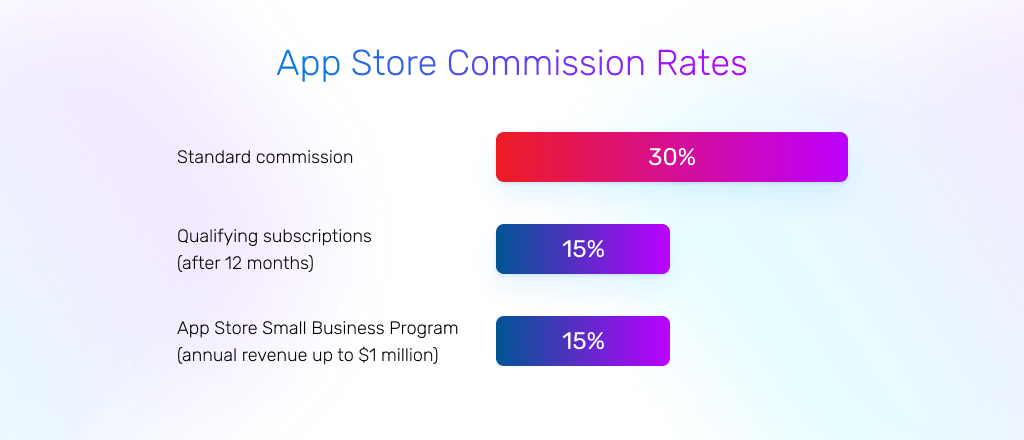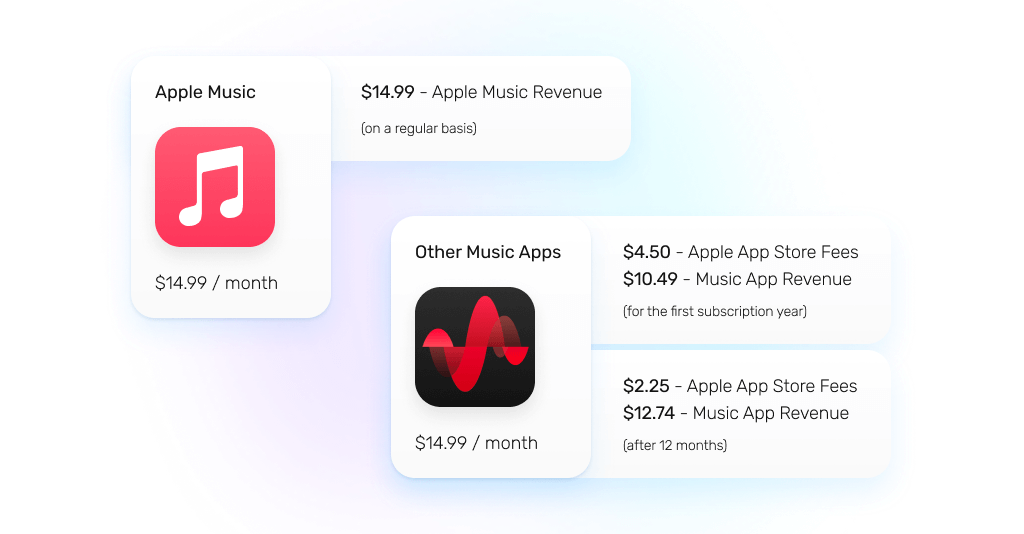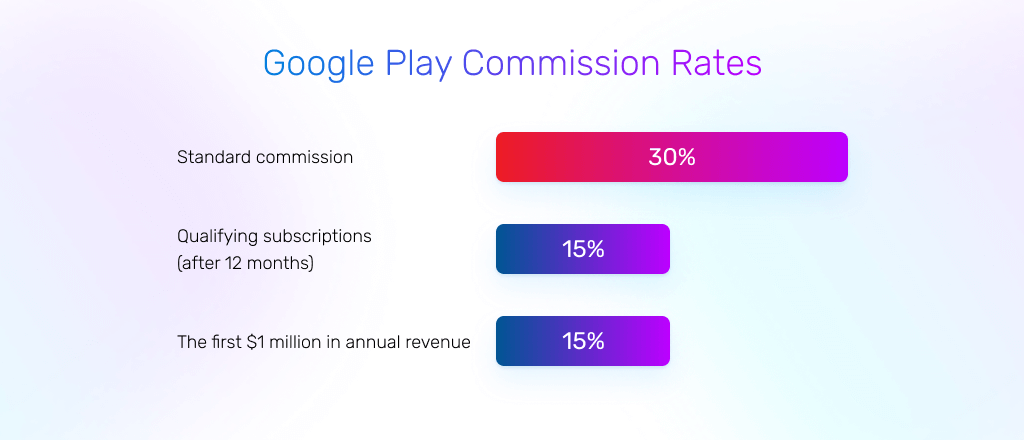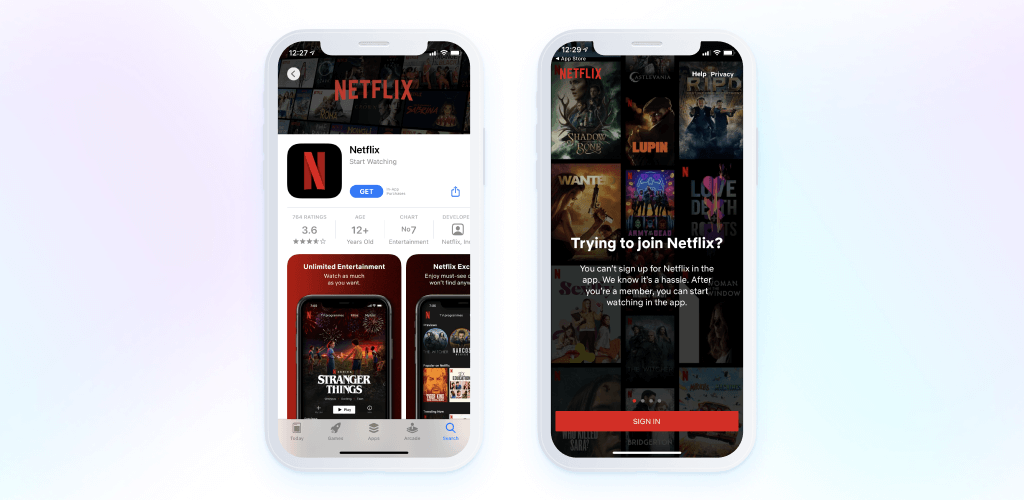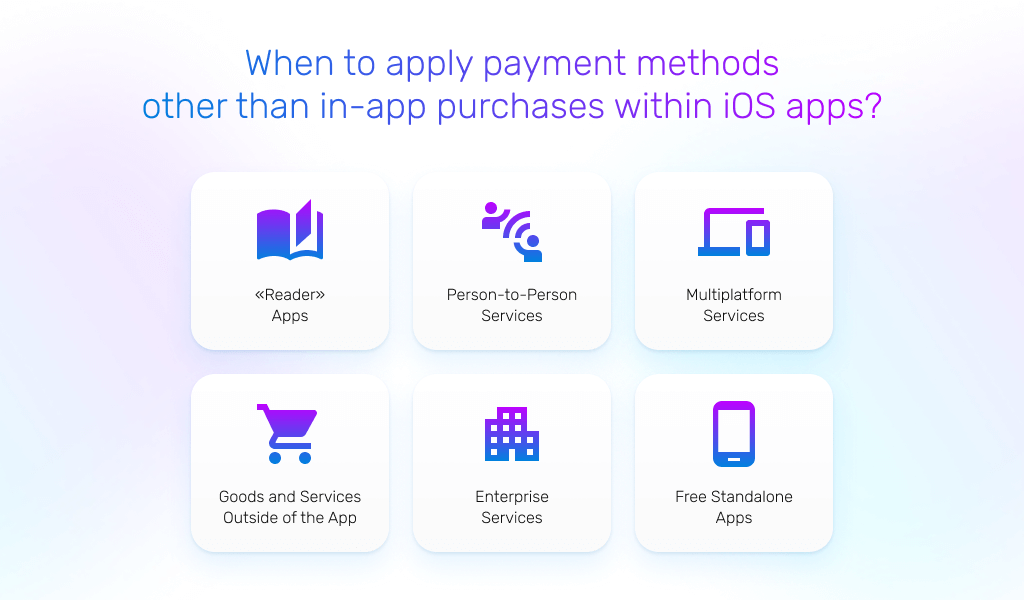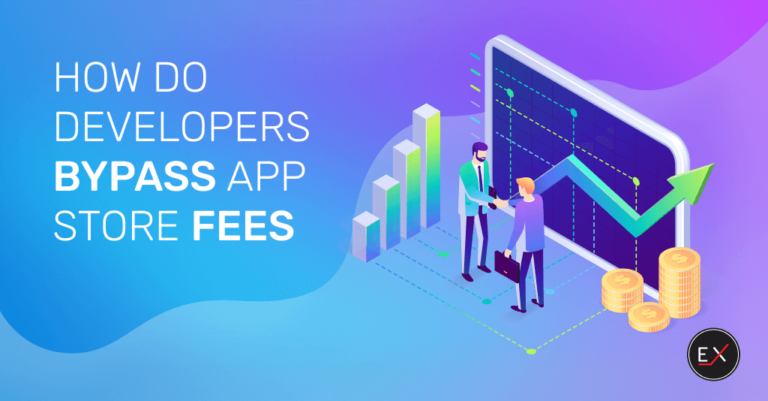
Updated: July 1, 2024
Published: July 9, 2021
Have you thought about how the App Store and Google Play make revenues? Taking into account the fact that the majority of applications are distributed for users for free, there should be someone who pays for that. If your answer was platforms themselves, you might have been mistaken. Actually, most of the expenses are covered by developers. There are standard Apple App Store fees and Google App Store commission taken from the revenue earned within the application. In this article, we’d like to take a closer look at the in-app purchase revenue share and how some developers bypass App Store fees and Play Store commission.
List of the Content
- App Store fees: the market situation in 2021
- Apple App Store fees
- Google Play Store fees
- How do developers bypass App Store fees?
- How do developers bypass the Play Store commission?
- Example with the workflow that bypasses App Store fees
- In conclusion
APP STORE FEES: MARKET SITUATION IN 2021
The explosive growth of mobile usage has considerably changed the ways of running your business. It has opened so many unique opportunities to get in touch with your customers, provide more value and offer improved products and services. Being one of the effective tools helps build a stronger brand and get better user engagement.
It is hard to find a company that hasn’t considered the idea of a mobile solution for their business. Besides, it can be turned into a stable revenue source. With various monetization models, teams benefit from new ways to make money out of digital products and services.
According to the statistics, the worldwide app revenue of the App Store reached over $72 billion and nearly $40 billion in Google Play in 2020. It is worth mentioning that figures are constantly going up as users’ spending increases by at least 25 percent each year.
But do developers receive all the money they earn within an app? As a typical middleman, platforms are taking the cut on revenue. Apple App Store fees and Google App Store commission have been under discussion for a long time. Many developers agree to the fact that they can’t find the in-app purchase revenue share quite fair. Moreover, both Apple and Google set numerous restrictions, including acceptance of other payment methods or promoting your own services within the application.
Besides, we need to mention the strong competition within the stores. The contributing factor is that both the App Store and Google Play present their own solution in almost every app category. Let’s take, for example, the development and distribution of the music app. There is no surprise that the main competitors are Apple Music in the App Store and YouTube Music in Google Play. Due to Google’s decision to focus on one music streaming application, they announced the closing of Google Play Music in 2020. However, all users were able to transfer accounts, playlists, and libraries to Youtube Music.
As a result, new market players find it quite difficult to compete with the aggregators and make their business profitable. Even the known companies have been in a long fight with Apple and Google. Many filed antitrust lawsuits claim app platforms to be monopolies and not be transparent about their rules and regulations.
The most known one is Epic Games vs. Apple battle, where they challenge the platform restriction on payment methods and a standard 30 percent cut on developers’ revenue. At the same time, Epic Games brought a similar lawsuit against Google. Even though the final decisions are still expected later in 2021, many companies joined the battle and created the Coalition for App Fairness to fight against the monopolistic control of Apple.
For instance, Spotify, a known audio platform, was among the first companies to bypass App Store fees. At first, they tried to increase the price of the in-app purchases to cover the revenue share. However, the users had the ability to purchase the plans at a lower price on their official website. At present, most purchases are completed outside of the app as they exclude the possibility to buy the premium plans there, explaining that more information can be found on the official website.
Even though Apple and Google deny charges of restrictions to developers, we have observed a number of positive changes in the app market. The standard App Store fees and Google Play Store fees have decreased with the introduction of new programs to support small developers and the commission cut on the subscription revenue. Obviously, such high fees are hard to justify by the scale of the app platforms. So stores seem to loosen certain restrictions and update policies to include some other payment methods.
Moreover, developers state that Apple and Google are quite controversial in their decisions. For instance, Apple has confirmed that they let Amazon Prime Video bypass App Store fees as they have a special program for video streaming providers. Apple didn’t comment on how long the program exists and how other developers can apply for it.
There is no surprise why more and more companies raise the question of cutting the App Store fees and Play Store commission and introducing transparent policies for everyone. So let’s discuss in more detail the current fees on each platform.
APPLE APP STORE FEES
The team should be aware of the smallest details related to the project, including what fees they have to pay in app stores. It isn’t about just checking the commission percentage but understanding how to make offers attractive for customers and profitable for your business. If someone thinks that a few percent revenue share makes little difference to the overall profit, they are totally mistaken.
In fact, taking commissions from developers is a stable revenue source for multi-billion dollar companies like Apple and Google. Development teams aren’t left with a big choice here. To distribute the mobile app among users, they need to get them listed in the App Store or/and Google Play while meeting set guidelines. In their turn, both platforms are more than eager to take advantage of that.
Even though they state no charging fees on distributing, hosting, or supporting applications, they set quite big commissions on the revenue made via the app, with an exception for several cases. So let’s start with addressing the question of how much the Apple App Store charges developers.
The first thing to mention is that every developer has to get enrolled in the Apple Developer Program. It means that they will get access to all the necessary documentation, development tools, get support, and connect to the big community. For all of these, they pay an annual fee of $99 for individual developers and $299 for the Apple Developer Enterprise Program. As a result, the membership is paid and agreed upon within the associated program license agreement.
Besides, Apple taxes developers on the revenue earned within the application. All transactions are subject to Apple App Store Fees, as it is mandatory to use the proprietary in-app purchase system. The distribution of paid digital content is under the control of the App Store. In simple words, Apple plays the role of the middleman between developers and users. Either you offer the paid app, introduce subscription plans or have in-app paid content, get ready to split your revenue.
The standard commission is 30% on every transaction made via the AIP system. For example, when you offer the paid app for $4.99, your earnings will be $3.49. It is not taking into account expenses on development, maintenance, updates, etc. Whereas the App Store will get $1.50 for each user getting your application. As a result of simple calculation, 1000 new users cost you $1 500 that you pay to Apple.
With all the questions raised around too high fees, Apple started to cut commission rates on revenue earned with the subscription model. As a result, the Apple App Store fees are decreased after the first subscription year. That means that developers are charged a 30 percent commission for 12 months, and after this period, they start to pay a 15 percent fee when the users remain subscribers. The subscription model quickly increased in popularity due to reasons like the constant revenue source and decreased commissions. However, the situation hasn’t changed considerably as they still need to pay Apple App Store fees. Adding the subscription plan with the monthly price of $9.99, for the beginning, Apple tax will be $3 per user and then $1.5 after 12 months. So if we count Apple App Store fees for two years for 1000 regular users, the team will be charged a commission of $54 000 in total.
How to develop an efficient app monetization strategy?
Learn more details on in-app monetization before planning and implementing your mobile application.
In many cases, developers have no other choice but to increase in-app prices to cover Apple tax and make their sales at least economically profitable for their business. That is especially related to small businesses that find it quite difficult to compete in the huge app market. The recent Apple announcement of the App Store Small Business Program, which started on January 1, 2021, was really surprising for most developers. This program features the cut commission rates of 15 percent to support small businesses and provide the opportunity for their growth. Though, to become the program applicants, developers have to meet certain requirements. This program is specially created for new developers to the App Store and existing ones that earn less than $1 million a year. In order to enroll in the program, the team shouldn’t make more than the specified amount for the 12 fiscal months. Moreover, if the team manages to make more than $1 million in the next year, they automatically requalify for 30 percent App Store fees. Even though it is a big step in commission cuts, everybody understands how easy the Apple App Store can set strict limits on most developers.
GOOGLE APP STORE COMMISSION
Continuing the topic on commissions, we also need to address the question “how much does Google Play charge developers?”. Building the mobile application, the team realizes the importance of listing it in both stores. It is not only the opportunity to reach a bigger audience but find more revenue sources.
More and more teams prefer to apply hybrid approaches that allow them to build a mobile application for both Android and iOS with twice less development time and resources. It’s worth mentioning Flutter application development gaining in popularity due to advanced functionality, fast delivery, and great performance.
How to benefit from cross-platform development?
Having extensive experience in mobile development, EXISTEK knows how to turn your ideas into successful products.
Everyone understands that limiting opportunities to certain platforms isn’t a good solution. It turned out to be a business requirement to complete the digital presence on various platforms. Google Play has successfully become the main middleman between developers and Android users. They state to have two billion Android users worldwide, whereas developers made an $80 billion revenue as of February 2020.
But what about the Google Play Store revenue split and how much developers actually shared with the store? Like the App Store, all the in-app purchases are subject to Play Store commission, so it becomes clear that Google Play itself has also generated huge revenue. All development teams are obliged to use Google Play billing to complete most in-app payments. Google Play uses almost the same scheme as Apple to drive the revenue, with a few differences we’re going to mention.
The first thing to consider is related to setting a developer account. Every developer is required to create an account usually linked to the Google account. Therefore, it is always better to set a dedicated Google account, especially for your app, than using a personal account. In order to complete the registration of the developer account, each applicant pays a $25 membership fee. There is a good thing about it that it’s a one-time registration fee without any further billings. They get full access to the development tools and services to build high-quality applications for a lifetime.
As for Play Store commission, it is applicable to all digital content and product purchases via the application. Google Play Store App charges the standard commission of 30 percent like the App Store. As a result, the teams have to be ready to split the revenue with both stores, especially when they launch paid applications on different platforms. Then the developer’s expenses on the commission double automatically. Taking back the sample of the paid app with the price of $4.99, 1000 new users in Google Play will also cost $1500 for the company.
The same situation remains with the subscription model, as Google Play Store fees are also cut after 12 months. At first, the team will be charged a standard 30 percent commission and only then switch to the lower fee rates. After the first subscription year, Google Play Store revenue share will number 15 percent. Even though the commission has decreased twice starting from 2018, it still boasts a high revenue for Google Play. We shouldn’t forget the fact that these fees are actually paid for your loyal customer. If you have retained your audience for that period, they definitely plan to stay with you longer and drive revenue not only for you but for Google Play as well. Having one loyal customer with a subscription plan of $14.99 costs you $2.25 per month, whereas the team has already paid $54 for the first year ($4.50 per month). These are simple calculations for one user that has purchased the average priced subscription. It won’t be a problem to estimate Google Play Store fees on the apps with a million user base. That’s why it’s no surprise why this question is so discussed on the market.
The latest breaking news is related to the Google Play initiative to boost the developer’s success on their platform with the announcement on March 16, 2021. It follows the introduction of the App Store Small Business Program by Apple. Though, Google Play has offered better conditions for their development community and explained this by supporting businesses at the earliest stages of growth. Starting on July 1, 2021, they will reduce Google Play Store Fees to 15 percent for the first $1 million made via in-app purchases. This Play Store commission is applicable for all developers as the revenue above $1 million will be charged the standard commission of 30 percent. It is a good advantage for small projects whereas the saved revenue (up to $150 00) can really make a difference in their profits.
HOW DO DEVELOPERS BYPASS APP STORE FEES?
Even though Apple doesn’t break down its business segment earnings, the App Store is definitely among the biggest contributors to Apple’s revenue. Considering that most developers take the chance to monetize an app, they automatically contribute to Apple’s profit. The high rates of Apple App Store commission are hard to justify, and more and more teams question limitations to the in-app purchase system. It is often regarded as a way to turn the App Store into a monopoly by any metrics.
Let’s take a look at payment methods the developers are allowed to use in their applications. It isn’t surprising that it is limited to payment methods accepted via Apple ID. For example, it covers the following options for users from the USA:
- Apple Pay
- Apple Card
- Apple Cash
- Apple ID balance
- Most credit and debit cards
- PayPal
As for users from other countries, you can check the full list of available payment methods by country and region. But it doesn’t change a lot as all the transactions are handled within the in-app payment system and make them subject to Apple App Store fees.
But what happens when developers want to apply other payment methods and bypass the Apple App Store commission? Such big platforms like Netflix and Spotify were among the first to fight against a 30 percent revenue cut. They have gone a long way to obtain some of the desired results. For example, at present, Netflix uses disabling the sign-up for new subscribers within an application. That means that new users have to visit the Netflix website and obtain new subscriptions through the web browsers. Only then can they use the purchased membership to start watching in the application.
Following the example of the known market players, many developers started to look for new opportunities to save their revenues. Actually, all the discussions around this topic have made Apple start loosening some terms. Even the Apple App Store commission cut to 15 percent for certain cases is regarded as a good result of a long-term fight.
Moreover, Apple has introduced a list of applications that are allowed to use other purchase methods. Consequently, developers of these apps have a fair chance to bypass App Store fees and drive some revenue through different channels. The fact is that they don’t have to violate App Store guidelines, including promoting other purchase methods within an app itself or use the information gathered here to promote their services. However, they have all the rights to build communication with their client base outside of the app and encourage purchase methods other than in-app ones via different channels.
For now, these regulations are applicable for the following app categories:
- “Reader” apps are often regarded as a complementary solution for the existing customers’ benefit. It can provide some additional features like account management; thus, it gets access to the previously purchased content or subscriptions. That is often used for distributing newspapers, magazines, music, books, videos, etc. Once the customer purchased the content subscription, for example, on the company’s website, they can access the content via the mobile app.
- Multiplatform services are allowed to let their users purchase content wherever they prefer. Their customers can make payment on other platforms though have full access to the paid content within an app. Though it also remains mandatory to include the same in-app purchases for the application from the App Store. It gives users freedom of choice as well as takes their needs first. In their turn, developers receive the new opportunity to bypass App Store fees when the customers prefer to complete payments on other platforms.
- Enterprise services are the next category that allows developers to directly sell to enterprises or their group of users. It involves enterprise employees, trainees, and students, whereas consumers or single users have to go with in-app purchases. As in the previous cases, enterprise users will have access to the content or subscriptions purchased outside the App Store.
- Applications that offer person-to-person services have the opportunity to collect payments via methods other than in-app purchases. This option can be suitable for individual medical practitioners, tutors, fitness trainers, financial consultants. However, the main requirement remains that they aren’t allowed to provide one-to-many or one-to-few services that are subject to in-app purchases.
- As the physical goods and services are consumed outside of the applications, app owners can also sell them via other payment methods. They will automatically bypass App Store fees due to the revenue collection through other channels.
- When the business specializes in web-based solutions, they often provide their users with free stand-alone mobile apps. This monetization strategy is quite effective as they are going to earn their revenue by selling web tools. Even though the mobile app excludes in-app purchases, the primary goal is to extend the user experience.
Therefore, it is a common situation for some developers to bypass App Store fees as long as they simply comply with App Store Guidelines. Sometimes it is important to think out of the box and extend your services to more than one platform or come up with some new solutions to meet the requirements of all the involved parties.
Have a great idea for your mobile application?
Feel free to contact our team. EXISTEK has first-hand experience and knows how to turn your ideas into advanced products leveraging the latest technologies.
HOW DO DEVELOPERS BYPASS GOOGLE PLAY STORE FEES?
There is no doubt that the ability to distribute an application on a big platform is highly beneficial for businesses. The main advantage focuses on the ideal opportunity to reach a vast audience. But at the same time, they face such challenges as strong competition, strict app store regulations, high commission on their revenue.
With the huge community of Android users, developers understand the necessity of getting their app listed in Google Play. Even though their regulations are sometimes considered less strict than the App Store ones, they cover similar restrictions on applying various payment methods and charge the same amount of commission on developers’ revenue earned within the app. That’s why the question of how to bypass the Play Store commission is also open for many Android developers.
Starting with the limitation to the accepted payment options on Google Play, development teams aren’t entirely free in choosing how to collect payments. The revenue earned in the app is split between developers and Google Play as all the purchases of digital content are completed within the Google Play billing system. In order to make a purchase, users choose between methods they have added to their Google accounts. Besides, these payment options vary by the county where you are going to distribute the mobile application. For example, in the USA, Google Play accepts the following payment methods for users:
- Google Pay balance
- Google Play balance
- Google Play gift cards
- Credit and debit cards
- PayPal
- Mobile phone billing carried by AT&T, Verizon, etc.
Unlike users who are given a good choice, developers become more and more restricted, especially regarding the set percentage of revenue earned from paid apps, digital content, and subscriptions taken for Play Store commission.
If we take such companies as Spotify, Netflix, and Tinder, they have managed to bypass Google Play Store fees by asking users to provide a credit card to pay them directly. However, this practice is no longer possible due to the Google Play announcement on September 20, 2020. They are getting stricter with their billing policies while making it a requirement to use the Google Play billing system. They have even given the time to the teams to integrate the billing system until September 30, 2021. As you remember, companies are currently fighting it out, and the case is under investigation.
However, it is possible to bypass Google Play Store fees for businesses whose sales comply with specific requirements and don’t require the usage of Google Play’s billing system.
- Mobile applications that sell or collect the rent of physical goods are allowed to add other payment methods. The revenue made through selling clothing or groceries doesn’t have to split with the Google Play Store.
- The following case focuses on the app that includes purchases of physical services. Mobile applications that provide such services as transportation, delivery, or cleaning fulfill requirements entirely and have the right to bypass Google Play Store fees.
- Also, they have mentioned applications that process remittance of bills, including payments for utility and credit card bills. It is obvious that these payments can’t be subject to any Google Play Store fees. Therefore developers are allowed to use some other payment methods.
- Like Apple, Google can’t set any limitations to peer-to-peer payments. Both app stores aren’t allowed to charge developers whose apps help users with personal money transfers. However, they have come with different solutions, like introducing their own digital payment apps like Google Pay and Apple Pay Cash.
It seems that Google Play tries to go even further than the App Store and hasn’t mentioned anything about previously purchased subscriptions and digital goods on other platforms. The one thing is clear that developers won’t leave these questions unanswered as many companies are currently finding the solutions workable for all sides.
EXAMPLE WITH APP WORKFLOW THAT BYPASSES APP STORE FEES
While developing the mobile app, the team has to be ready to accept some of the common challenges. The first one is related to the necessity of high-quality software. The team has to put lots of effort into implementing the best ideas, unique functionality, impressive designs, and latest technology to present their solutions. It is always important to focus on quality as a powerful tool to drive new customers to your business.
The second challenge is about the ability to grow your client base and support user engagement. You need to find ways to distribute your products and services, deliver a unified user experience across different channels, and come up with effective marketing strategies.
The last one but not the least is how to earn money with your application. It’s obvious that constant profit allows businesses to evolve successfully. More and more teams seize the opportunity to boost revenue with available monetization models.
Along with defining the functionality of your future application, the team has to develop a plan for distributing and monetizing these solutions. In order to come up with the most efficient approaches, you need to be aware of everything that might impact your project.
How to approach custom mobile development?
Find a step-by-step guide to the development process and how to organize effective collaboration between the service provider and the client.
The explosive growth of mobile use has greatly changed market demands for business. More and more customers prefer to have everything accessible within the tap on the mobile device. It is rather important to give your users this possibility by offering mobile applications. It goes without saying that listing the application in both the App Store and Google Play definitely increases chances to reach more customers and grow the bigger user base.
Though every company understands that paying Apple App Store fees and Google Play commission takes away a considerable part of their profit, it doesn’t mean that you need to give up your decision on making a profit with your application. There are a number of great ways to plan your monetization strategy and drive good revenue for your business. Moreover, companies have a chance to avoid App Store fees and Google App Store commission while meeting the necessary requirements.
Let’s take an example to show how using the specific workflow allows companies to bypass App Store fees and Google App Store commission. The first requirement is to fall under the category that allows developers to use other payment methods. If you manage to collect payments by other means than stores’ billing systems, your application can automatically avoid paying these fees.
Companies shouldn’t forget that they can always collect payments on other platforms, for example, web browsers. All businesses have the right to communicate with their users through numerous channels. If developers are restricted within an application, they have other options to choose from. The suitable workflow can include using a company’s website for collecting payments, whereas the mobile applications are presented as an additional way to improve user experience. It is quite similar to the workflow Netflix and Spotify use for their business.
It shouldn’t be regarded as an easy solution, as it leaves companies with numerous details to cover here. Firstly, they need to find effective ways to drive users to their website, whereas that is not allowed within a mobile application. Developers don’t have to use any ways to lead their customers from the app, even if they use a different payment method.
That’s why the application shouldn’t contain:
- In-app promotion of paid content
- Advertisements
- Push notifications, messaging about paid content
- In-app webview, links, and buttons
- Calls to action
In simple terms, this workflow relies upon the company’s ability to change how users get to know about their products and where they purchase the digital content. When the company collects payment through the web browser, they will avoid paying App Store fees and Google App Store commission.
Though with the recent situation about the commission cut and loosening app store policies, the future could be promising for many businesses. It’s obvious that the app stores are going to leave some fees. But they can’t set them so high to make developers find ways to bypass App Store fees or Google App Store commission.
IN CONCLUSION
We hope you have found answers about the app market situation, current Apple App Store fees, and Play Store commission. Regarding the unique opportunities to drive revenue through the mobile application, there will always be some related challenges. Developers have to put lots of effort into building quality products, distributing them among users, and finding ways to monetize their solutions. The most important things will remain careful planning and a well-designed strategy for distributing your products and services. The need to list the application in the App Store and Google Play is understandable, whereas not everyone agrees with high app store fees on in-app purchase revenue. Developers are ready to fight for commission cuts while supporting free and secure app environments.
Have additional questions or want to discuss your app idea?
Feel free to contact EXISTEK. Being focused on functionality and performance, we know how to build both a quality mobile application and an efficient monetization strategy for it.
Frequently asked questions
How much tax does Apple charge for apps?
The App Store charges developers:
In-app purchase revenue share of 30 percent
15 percent on subscriptions (after the first 12 months)
15 percent for the participants of the App Store Small Business Program (annual revenue up to $1M)
How much does Google charge app developers?
Google Play Store charges for apps:
30 percent of Google Play app revenue share
15 percent on subscriptions (after the first year)
15 percent on the first $1M in annual revenue
How do developers avoid paying app store fees?
In order to bypass app store fees, developers have to use payment methods other than the in-app billing system. It is permitted to applications that comply with the store regulations and belong to a certain category like apps selling physical goods or services. Besides, developers aren’t forbidden to encourage purchases outside of the app unless they use the in-app means to reach users.
What companies bypass app store fees?
There is a growing number of companies that manage to avoid paying app store fees. The most known ones are:
Epic Games
Netflix
Spotify


